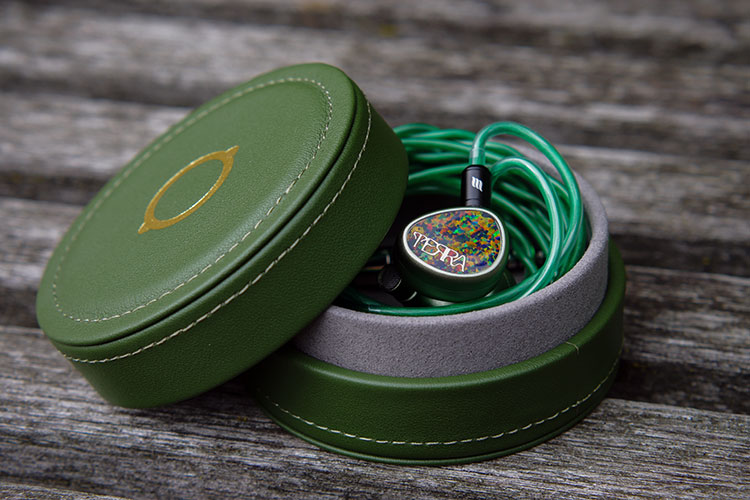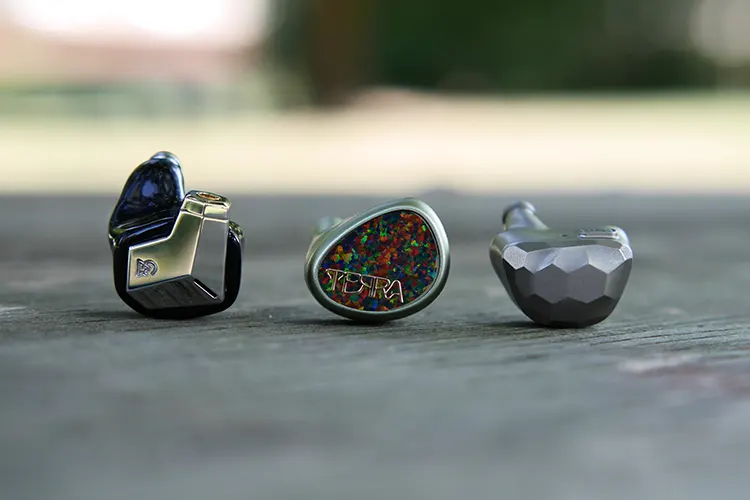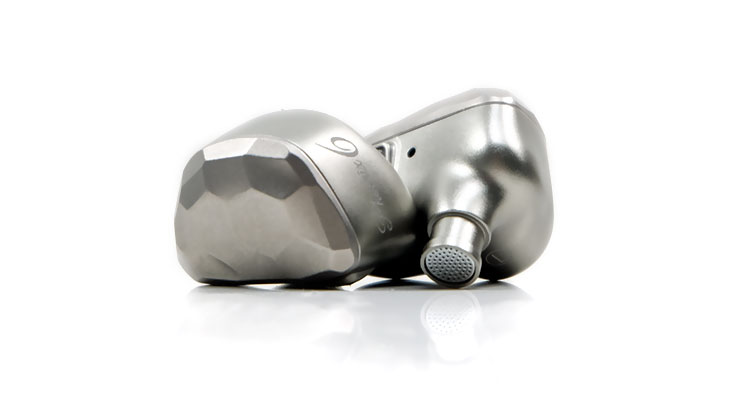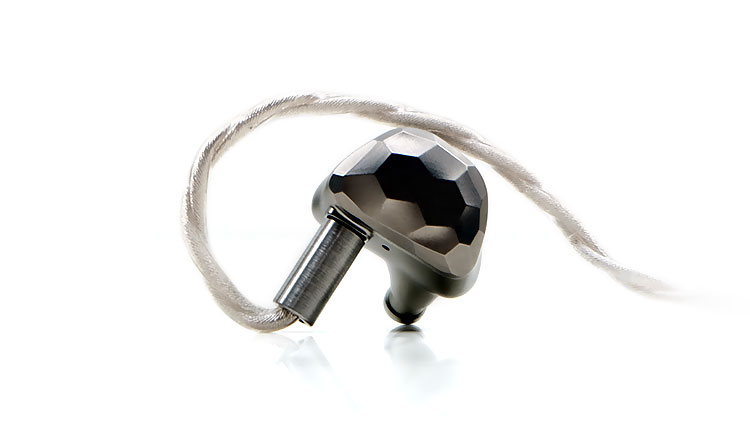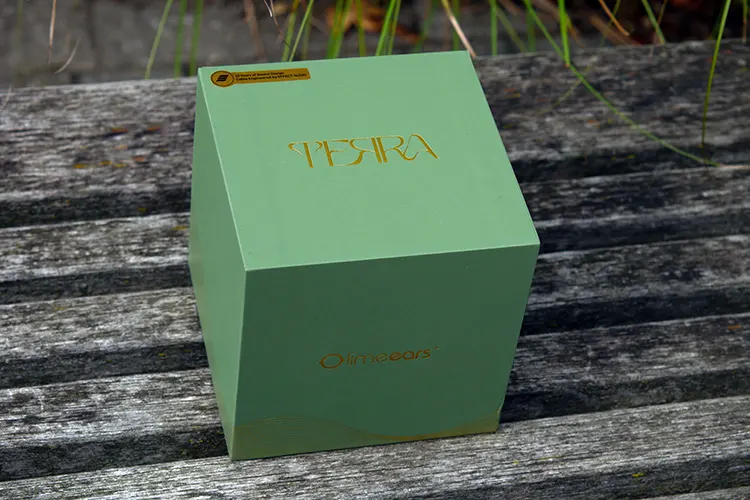Select Comparisons
Campfire Audio Supermoon
Technical
The Supermoon uses a single, large 14.2mm, full-range planar magnetic driver versus the TERRA with a hybrid setup using a 7mm dynamic for the lows, twin armatures for the low-mids, twin armatures for the hi-mids, and a Knowles RAU HERO super tweeter for the highs.
The build of the Supermoon uses 3D-printed acrylic married to a stainless-steel back plate with MMCX ports for cable. The TERRA uses aluminum for the entire shell except for the intense PISO faceplate, with 0.78mm 2-pin ports for the cable.
Using a planar magnetic driver, copper/beryllium MMCX ports, and 3D-printed shells are the main tech highlights of the Supermoon.
In comparison, the TERRA is rich with goodies, like variable bore sizes to help tune the different driver groupings, a titanium-coated diaphragm for the dynamic driver, and the new RAU armature from Knowles that emulates the performance of a ribbon tweeter.
The Supermoon is easier to bring up to listening volumes than the TERRA.
Design
Looking first at visual appeal, it’s hard to take your eyes off the TERRA. While the Supermoon is a good-looking earphone, the sample I have in black is very subtle compared to the TERRA, with only the polished stainless steel back plate and orange cable highlighting stirring potential glances from the general public.
The TERRA’s simulated opal faceplates look fantastic, especially when catching the light, and are firmly backed by the green shells and cable. It’s certainly one of the cooler-looking earphones I’ve had the pleasure of testing.
Ergonomics and wearing comfort are squarely in the Supermoon’s camp, however. While also a large earphone, the Supermoon’s design comes from averaging thousands of ear impressions, and as such it expertly disperses weight around the outer ear while hugging it tightly.
In contrast, the TERRA feels clumsy to wear with support coming almost exclusively from the ear tips and cable arches, though the lack of a chin cinch limits their effectiveness.
I must commonly reseat the TERRA to regain a good seal or to give my inner ear a break, an action rarely taken with the Supermoon.
The Supermoon’s ear-filling design and lower profile fit give it a notable advantage when passively blocking outside noise. And oddly, while quieter, outside voices bleeding through are clearer and more intelligible.
Bass Performance
Neither model is shy about the quantity of bass they offer, though, to my surprise, the TERRA gives you more. Sub-bass emphasis is stronger on the TERRA, giving it a more rumbly, visceral presentation versus the Supermoon which better balances its great bass depth and mid-bass warmth.
Texturing on both is fantastic, but the TERRA improves upon the Supermoon. Notes have more depth and feeling, and gritty effects stand out more. Through the Supermoon, notes are smoother and less detailed.
Speed and control are where the Supermoon’s planar magnetic driver takes a big step forward. On congested and quick sections where the TERRA’s 7mm dynamic distorts at high volumes and smears notes, the Supermoon’s planar remains unphased with every beat coming through distinct.
Mids Performance
Both models have a U-shaped signature with slightly scooped mids. The Supermoon’s midrange is more forward, though the difference is minimal with vocals and instruments sitting at nearly the same level of emphasis in most instances.
The biggest difference is in the default vocal positioning which is closer to the inner ear on the Supermoon, giving it a more intimate vocal presentation.
The Supermoon’s planar better handles micro-detail and clarity, with vocals and instruments showing improved clarity and coherence. A thinner note presentation compared to the TERRA further helps with this.
Sibilance is present on both models, though it is handled considerably better on the TERRA. The Supermoon does little to mitigate a hot vocal mastering, while the TERRA takes a lot of the edge off resulting in a better listening experience.
Treble Performance
Campfire Audio’s Supermoon emphasizes the brilliance region further giving it an even more vibrant and sparkly upper range than the TERRA.
Unfortunately, this also highlights how much less refined the upper ranges are, coming across as somewhat crude and overly tizzy next to the TERRA’s smoother, cleaner presentation.
Even with this additional refinement, the TERRA doesn’t fall behind in detail and note definition. It matches what the Supermoon offers despite the TERRA having a thicker presentation overall.
Unsurprisingly, the Supermoon’s brighter tune and harsher performance in the upper ranges leave it the more tiring earphone to listen to at high volumes and over longer listening sessions.
The TERRA’s more controlled upper ranges also benefit from its improved note definition. On tracks where the Supermoon can sound quite splashy, the TERRA is better controlled with clearer individual notes.
Staging Performance
Liem Ears did a fantastic job giving the TERRA a spacious stage, and one that bests what Campfire Audio’s Supermoon pulls off. The TERRA’s stage is wider and deeper but offers only a small advantage in terms of height making the Supermoon’s stage more well-rounded, albeit smaller.
The width advantage of the TERRA is especially noticeable in channel-to-channel transitions where effects can be tossed well off into the distance, beyond what the Supermoon offers. Intimate effects and vocals are more evenly matched though.
These transitions are smooth and accurate on both models. The Supermoon is more accurate off-center though, making it the better option for gaming where this quality matters.
Despite the smaller staging, the Supermoon goes head-to-head with the TERRA in the effectiveness of layering and instrument separation. Its leaner sound allows listeners to pick out individual track elements just as well, and it gives off just as dynamic a level of depth
Astrotec Phoenix 6
Technical
Astrotec’s Phoenix 6 uses a tri-brid driver configuration with quad Sonion electrostatics for the highs, a Sonion armature for the mids, and one of their custom dynamic drivers of unknown size handling the low.
The TERRA has a hybrid setup with a 7mm dynamic with a titanium diaphragm for the lows, two armatures for the low-mids, two armatures for the mid-highs, and a Knowles RAU armature for the upper ranges.
Both models have metal-bodied shells with varying designs and feature 0.78mm 2-pin ports. The Phoenix 6 has a smooth inner shell with mild ear-hugging protrusions and a hexagonal outer faceplate, all crafted from titanium, while the TERRA is smooth aluminum back to front with a vibrant, simulated opal faceplate.
Beyond the driver configuration, titanium shells, and a silver-plated 4.4mm balanced OFC cable, Astrotec doesn’t hype any particularly interesting tech in the Phoenix 6. In comparison, the TERRA is packed to the brim and contains TiTE, HERO, VariBore, SAAS, and PISO.
Getting up to comfortable listening volumes is easier through Astrotec’s Phoenix 6.
Design
Both are good-looking earphones, with the Phoenix 6’s shells being considerably more subtle with their bare titanium exterior and textured faceplates. Until you close in and examine the finer details, there is little to the Phoenix 6 to draw looks from passersby.
The one exception is the vibrant silver-plated cable and its steel and brass-colored hardware. It’s a more mature, handsome cable with improved wearing characteristics over the also-impressive Effect Audio cable included with the TERRA.
While both models contain six drivers per side, Astrotec installed them within a smaller, more ergonomic, and comfortable shell.
Whereas I can wear the Phoenix 6 for extended periods without experiencing any discomfort from hot spots, the TERRA’s long nozzles and limited weight distribution cause discomfort in the inner ear and require regular re-seating to get them sitting properly.
Build quality on both is excellent. There are no issues with part fitment, molding quality, unreliable connectors, poorly installed nozzle protection, or other potential concerns.
Lime Ears’ TERRA isolates better than the Phoenix 6. Voices and higher-pitched sounds in particular are more prominent through the Astrotec.
Bass Performance
Both models dig deep and provide plenty of visceral feedback. The Phoenix 6 has a more even balance of mid- and sub-bass presence but has a cooler tonality, while the TERRA is warmer and more sub-bass-focused.
The TERRA offers better texturing and notes slam more aggressively. Astrotec’s Phoenix 6 dynamic decays more rapidly allowing rapid notes improved definition and separation.
Lime Ear’s titanium-coated diaphragm provides improved texturing over what the Astrotec offers, giving grungy notes great depth. The Phoenix 6 isn’t far behind though, and still provides a heavily textured experience.
Mids Performance
Vocals through the Astrotec sit further forward with a default positioning just inside the outer ear. On the TERRA, the default positioning is just outside the inner ear.
The TERRA’s abundant low end stands out on vocal-centric tracks, with the reduced mid-bass emphasis ensuring there is little bleed to affect intelligibility. In comparison, while the Phoenix 6 is nearly as bass-rich, the pushed mid-range ensures the two regions better share the limelight.
Detail and clarity are similarly good on the two, with the TERRA’s additional mid-range drivers giving it an edge. Micro-details are more prominent, and notes are better differentiated giving it a more refined presence.
The warmer mids of the TERRA come across as more natural, with female vocalists and stringed instruments benefitting most. Both models handle sibilant recordings well, though the Phoenix 6 takes the edge off sizzling tees and esses slightly more effectively.
Treble Performance
Both models offer extension well beyond the range of human hearing with the Phoenix 6’s quad electrostatic setup being even more impressive than the RAU armature handling the TERRA’s highs.
Despite this extreme extension, neither model overdoes emphasis, and each has a pleasant treble presentation.
That said, the Phoenix 6 is more focused on the presence region giving it the edge in upper-end clarity and note definition.
The TERRA on the other hand is more energetic and livelier, with a sound richer in sparkle and shimmer, coming at the expense of being more fatiguing over long listening sessions.
While the Astrotec offers improved clarity and more well-defined notes, both suffer from a hint of looseness, or splash. The TERRA handles this better, giving the impression of a more refined presentation.
Staging Performance
While no slouch in the staging department, the Phoenix 6’s presentation lacks the spaciousness of the TERRA. The closer default vocal positioning sets the tone, giving sounds less space to move inwards, or away thanks to a more confined stage.
It also lacks the height and depth of the TERRA’s staging. This results in a more confined sound stage in every direction.
Imaging on both models is handled well with smooth channel-to-channel transitions. Off-center accuracy is better through the Phoenix 6 though, as it becomes somewhat vague on TERRA when you’re nearing the center mark.
Layering is handled better through the TERRA where the wide bass floor gives a solid foundation on which the rest of the stage builds. The Phoenix 6 is excellent too, but the more confined stage limits the depth and spaciousness that makes the TERRA so effective.
Instrument separation is closer, with each model able to effectively distinguish individual track elements without much smearing or congestion. The speed of the Astrotec’s drivers gives it an edge in the low and high ranges, while the TERRA claims the mids.
My Verdict
Lime Ears has crafted a gorgeous-looking and sounding earphone in the TERRA. The vibrant green colorway and stunning PISO faceplates look awesome in person, and the tuning of the U-shaped signature is mature and competent.
I especially enjoy the spacious sound stage and deep, textured bass, as they provide an immersive experience you can easily get lost in. The TERRA offers one of my favorite examples of this tune, on par with the best of similar products I’ve tested.
Ergonomics are the TERRA’s Achilles Heel for my ears. It’s a challenging earphone for me to wear for moderate periods. It never felt as secure as I’d like, the big nozzles caused discomfort, and the lack of a built-in chin cinch meant I had to craft my own to improve the fit or swap out the cable for something with the features I needed.
The usability of the TERRA is the only thing preventing it from getting an asterisk-free recommendation for anyone looking for a high-end earphone with a quality U-shaped tuning.
Lime Ears TERRA Technical Specifications
- 6 drivers, hybrid construction, four-way crossover
- One 7mm Titanium-Diaphragm DD for infra-sub frequencies
- Two BAs for low-mid frequencies
- Two BAs for mid-high frequencies
- One Knowles RAU New Generation BA for ultra-high frequencies

